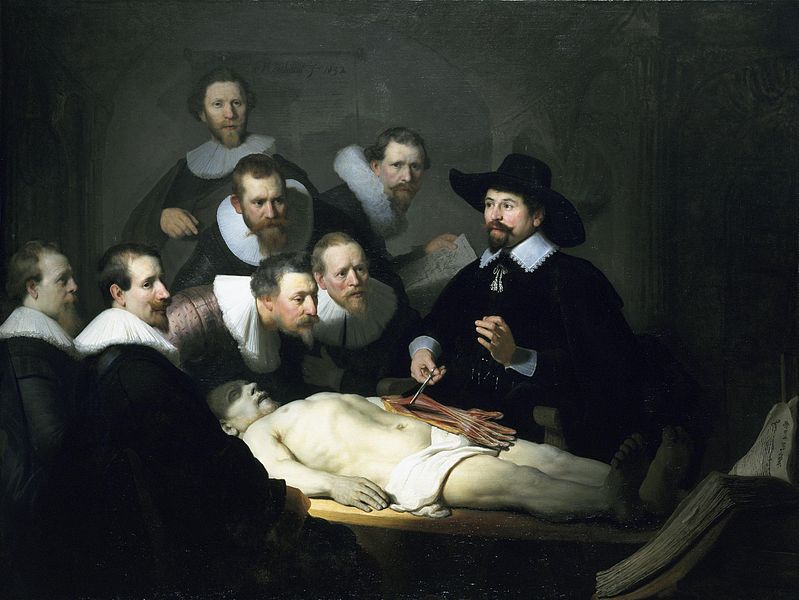There are eight of them around the livid corpse. It is a display of imperial power to a paying and wealthy audience. All but one them ignores the body. They look instead at the open book at the right hand side. Or in two instances, out at us, the onlookers. Another man, closest to us, takes a sideways glance. Meanwhile the one man touching the body with his metal implement looks high and away into the ether, astonished by his own sublimity.
These are, they have no doubt, Great Men. They don’t know the phrase “great men make history” because it will be said two hundred years into their future, but if they did, they would agree with it. The G8. The Great. Who are resolutely trying not to notice the death in their presence. Let’s call that death Capitalism. It’s an odd death because the G8 are trying to learn about life from it from the dissection and the anatomy lesson.
But these are contemporaries of John Donne. They do not ask for whom the bell tolls because they know very well. It’s for them, just as much as it is for the living dead corpse of Capitalism in front of them. Like the vampire, capitalism dies in a regular cycle, returning to a passive state of money before it goes off on the rampage again. The Great have always been confident that they know how to raise the corpse. Only now, some two hundred and fifty odd years into their undead lives, they are not so certain.
The tricks they have tried in the past have not moved the corpse in the way they have come to expect. But they are undead too and they have no others. Free trade, they say. Less regulation. Yet more tax cuts. But the ones looking out, rather than fixing their gaze at the book of all truths–maybe it’s now Ayn Rand they look at–know that things are not going so well. The corpse is that of a man named Aris Kindt, a thief. One of their own. So they cannot look at him.
Out in front of this scene was Rembrandt once. He painted them in The Anatomy Lesson of Dr. Tulp (1632). In its frozen tableau are both the certainty and fears of emerging capitalism. This weekend I found the painting reproduced in a book that I had first read many years ago by W. G. Sebald, called The Rings of Saturn. Having trouble sleeping, as I often do these days, I opened it and at once began coughing from its dust and the already decaying pages of the cheap British paperback.
Sebald lived in the U.K. although he was German by descent and wrote in that language. He is the supreme writer of melancholy, a German haunted by the twentieth century and living on the wind-swept marshes of East Anglia. Rings of Saturn begins by a meditation on The Anatomy Lesson and Sebald’s speculation that one of the eight was Thomas Browne, a poet of melacholy. Browne did one visit Tulp’s displays of erudition for the wealthy bourgeois of Amsterdam, so why not say that he is painted here?
As I tried to sleep, the image shifted in my mind, linked to the contemporary Anatomy of Melancholy by Richard Burton, and became the Anatomy of Capitalism. But that is to say the same thing. Melancholia, Freud reminds us, is mourning that has not been resolved. It is our refusal to let go of the lost object that keeps us in a state of melancholy, a condition in which we see ghosts. Which is not to say that the ghosts are not real. Must a ghost, I thought, always do the same thing? Hamlet’s father chooses when to speak and when not to speak. So does that other ghost that haunted Europe first but the United States later and more scarily, das Gespenst der Kommunismus, the ghost of communism. That ghost has had little to say for quite a while. Is it not once again in the wings, awaiting its entrance?
Why, I wondered, do those three Dutch merchants look out at us like that? Are they afraid we know something they don’t? Are they worried that we might come in and mic check the anatomy lesson? Or are they just keeping us in our place, the place allocated to us from which we may look at them and nothing else? In its lights and darks, with sharp perspectives, the scene is all about who can see what from where and what they make of it. What does Aris Krindt see as he lies there with his neck broken by strangulation–so civilized, Holland–looking up into the jowls of the burghers and their hipster goatees?


Ah, Dian you got me there–sometimes the free flow of association lets you down in the middle-aged mind in the middle of the night!
It’s Tulp’s book of anatomy: so they’re looking at the book rather than the body
Tell me about it!! In the middle of the day as well (for me, at least).
What does the book represent? The one they’re staring at in the corner.
I think it was Robert Burton who wrote The Anatomy of Melancholy, no? Browne wrote, among other things, Urne Buriall (which the wonderful Caribbean poet Derek Walcott cites in his poem, Ruins of a Great House–linking back to empire).
Corrected! Thanks:)